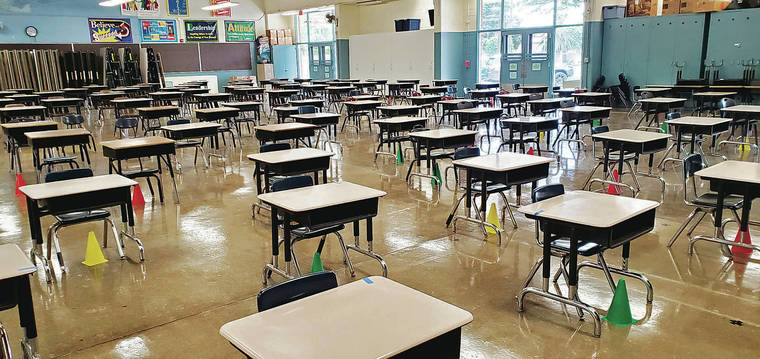Hawaii teachers union calls for delay in students’ return to school

COURTESY CHERYL KUROIWA
Desks are arranged 6 feet apart so students can maintain social distancing while eating lunch in the cafeteria at Nimitz Elementary School once the school reopens.
The Hawaii State Teachers Association is urging the Board of Education to postpone the return of students to public school campuses, saying educators need more time to prepare to work in the COVID-19 era.
Teachers are supposed to report for work July 29, while students are set to arrive Aug. 4. That gives teachers only four days on campus before the students return — the same as any other year.
“HSTA has no confidence that our school buildings are ready to open for our students,” Corey Rosenlee, union president, said Tuesday during an online news conference. “Our schools need more time to be able to create a healthy environment for our students and our teachers. Opening our schools quickly is not something we should do in a pandemic.”
>> RELATED STORY: Coronavirus concerns nudge some teachers toward classroom exits Opens in a new tab
Rosenlee declined to give a date when students should return, saying, “The first thing to do is make sure it’s safe, that our teachers feel comfortable, that our teachers feel trained.”
The HSTA’s request for a delay came a day after Gov. David Ige, board Chairwoman Catherine Payne, schools Superintendent Christina Kishimoto and state Epidemiologist Dr. Sarah Park joined forces in favor of the Aug. 4 opening date Opens in a new tab. Students are scheduled to attend school only in the morning for the first two weeks, with teacher training in the afternoon.
Don't miss out on what's happening!
Stay in touch with breaking news, as it happens, conveniently in your email inbox. It's FREE!
The state leaders expect August to be a relatively safe month for students and teachers to get together before the expected return of tourists in September. Travelers may opt to avoid the mandatory 14-day quarantine by getting tested for COVID-19 Opens in a new tab starting Sept. 1 — a date that itself was postponed by a month.
But the union says concern about the Aug. 4 date is widespread among educators.
“Leadership at all levels except those at the very top are privately expressing to us that it’s a plan that is being implemented too soon,” said Osa Tui Jr., vice president of the union and registrar at McKinley High School.
“Hawaii’s low (COVID-19 infection) numbers have been touted, and that is because we’ve had best practices so far,” Tui said. “It’s painfully obvious that what is about to happen is not best practice. … We made a wise decision to pause the reopening of our state, and it’s time to make a wise decision and pause the reopening of our schools.”
Union officials say there are still too many unanswered questions about safety precautions and logistics, from the use of face masks to how parents can opt into distance learning and what will happen when someone associated with a school tests positive for the disease.
“There are no clear protocols when it comes to face mask use,” Rosenlee said. “And what we’ve heard from teachers is that it runs the gamut across the state, where some schools are going to require and others are not going to insist on students having it on. HSTA believes that face masks must be worn, and that must be enforced on our campuses.”
Kishimoto has said face coverings for students and adults will be the norm but that teachers will have some discretion with young children in their classrooms.
School officials point to the Department of Education’s Return to Learn Opens in a new tab school reopening plan, which is posted online and covers health and safety, school design, equity and access, operations, staff capacity, family/community and contingency planning.
“The DOE has a plethora of information at its website, but teachers and staff need time to unpack that information so we know not only what is expected, but how to do it,” said Shannon Kaaa, a special-education preschool teacher at Fern Elementary School in Kalihi.
The Health Department will take the lead if a COVID-19 case crops up connected to a school, according to the Return to Learn plan. Health officials will determine who needs 14-day isolation and whether an entire classroom or more needs to close and students switch to distance learning. Park, the state epidemiologist, said the department will follow guidance from the Centers for Disease Control and Prevention.
But Pearl City High School science teacher Brandon Cha still had lots of questions.
“How many infected students does it take to outright close the classroom or the school?” Cha asked. “For example, if a single student from my classroom gets COVID, will all of my students have to learn from home through distance learning? Will the entire school shut down?”
“And who will shoulder the blame if a student, family or school staff member gets infected or dies because of COVID and it can be proved to be traced back to school transmission?” he asked. “These are important plans that need to be clearly spelled out in all their ramifications and consequences and communicated to both school staff and parents, who will inevitably be on the front lines.”
Other questions the union has include whether enough personal protective equipment will be available for the start of school and even how many teachers will come to work under these conditions — and whether there will be trained substitutes available.
“One of the reasons we have to take a gradual approach,” Rosenlee said, “is we have to see how many teachers are going to be there on the first day.”



